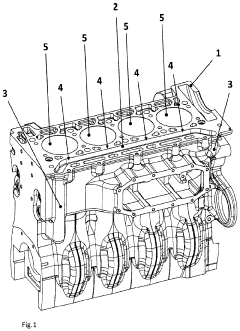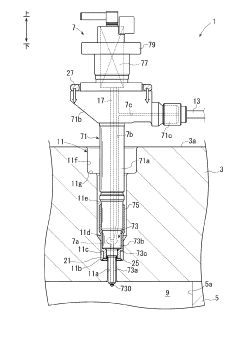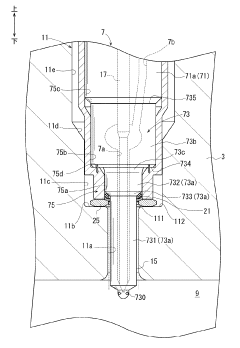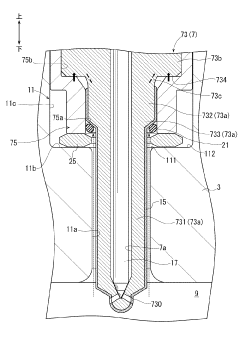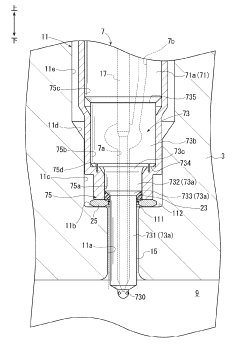K24 Engine Structural Integrity: Key Design Considerations
JUL 3, 20259 MIN READ
Generate Your Research Report Instantly with AI Agent
Patsnap Eureka helps you evaluate technical feasibility & market potential.
K24 Engine Background
The K24 engine, developed by Honda Motor Company, represents a significant milestone in automotive engineering. Introduced in the early 2000s, this inline-four cylinder engine was designed to meet the growing demand for high-performance, fuel-efficient powertrains in compact and mid-size vehicles. The K24 engine family has been widely utilized across various Honda and Acura models, gaining popularity for its versatility and reliability.
Initially conceived as an evolution of the F-series engine, the K24 incorporated advanced technologies to improve power output, fuel economy, and emissions performance. The engine's design philosophy centered on achieving a balance between performance and efficiency, making it suitable for a wide range of applications, from everyday commuters to sportier vehicles.
The K24 engine features an aluminum block and cylinder head, contributing to its lightweight construction. This design choice not only enhances fuel efficiency but also improves the vehicle's overall weight distribution and handling characteristics. The engine's displacement of 2.4 liters strikes a balance between power delivery and fuel consumption, making it an ideal choice for various vehicle segments.
One of the key innovations in the K24 engine is the implementation of Honda's i-VTEC (intelligent Variable Valve Timing and Lift Electronic Control) system. This technology allows for optimized valve timing and lift across different engine speeds, resulting in improved low-end torque and high-end power output. The i-VTEC system has been a cornerstone of Honda's engine technology, contributing significantly to the K24's performance and efficiency.
Throughout its production run, the K24 engine has undergone several iterations and improvements. These updates have focused on enhancing power output, reducing emissions, and improving overall reliability. The engine's adaptability has allowed it to meet evolving emissions standards while maintaining its performance characteristics.
The K24 engine's success can be attributed to its robust design and engineering principles. Its structural integrity has been a critical factor in its longevity and reliability, with many K24-equipped vehicles surpassing high mileage milestones without significant mechanical issues. This durability has contributed to the engine's positive reputation among consumers and automotive enthusiasts alike.
As automotive technology continues to advance, the K24 engine serves as a benchmark for future engine development. Its design considerations, particularly in terms of structural integrity, provide valuable insights for engineers working on next-generation powertrains. The lessons learned from the K24's development and real-world performance continue to influence engine design strategies, especially in the context of balancing performance, efficiency, and durability.
Initially conceived as an evolution of the F-series engine, the K24 incorporated advanced technologies to improve power output, fuel economy, and emissions performance. The engine's design philosophy centered on achieving a balance between performance and efficiency, making it suitable for a wide range of applications, from everyday commuters to sportier vehicles.
The K24 engine features an aluminum block and cylinder head, contributing to its lightweight construction. This design choice not only enhances fuel efficiency but also improves the vehicle's overall weight distribution and handling characteristics. The engine's displacement of 2.4 liters strikes a balance between power delivery and fuel consumption, making it an ideal choice for various vehicle segments.
One of the key innovations in the K24 engine is the implementation of Honda's i-VTEC (intelligent Variable Valve Timing and Lift Electronic Control) system. This technology allows for optimized valve timing and lift across different engine speeds, resulting in improved low-end torque and high-end power output. The i-VTEC system has been a cornerstone of Honda's engine technology, contributing significantly to the K24's performance and efficiency.
Throughout its production run, the K24 engine has undergone several iterations and improvements. These updates have focused on enhancing power output, reducing emissions, and improving overall reliability. The engine's adaptability has allowed it to meet evolving emissions standards while maintaining its performance characteristics.
The K24 engine's success can be attributed to its robust design and engineering principles. Its structural integrity has been a critical factor in its longevity and reliability, with many K24-equipped vehicles surpassing high mileage milestones without significant mechanical issues. This durability has contributed to the engine's positive reputation among consumers and automotive enthusiasts alike.
As automotive technology continues to advance, the K24 engine serves as a benchmark for future engine development. Its design considerations, particularly in terms of structural integrity, provide valuable insights for engineers working on next-generation powertrains. The lessons learned from the K24's development and real-world performance continue to influence engine design strategies, especially in the context of balancing performance, efficiency, and durability.
Market Demand Analysis
The market demand for advanced engine technologies, particularly those focusing on structural integrity like the K24 Engine, has been steadily increasing in recent years. This growth is driven by several factors, including stricter emissions regulations, the push for improved fuel efficiency, and the ongoing pursuit of enhanced performance in both consumer and commercial vehicles.
In the automotive sector, there is a growing emphasis on lightweight yet durable engine designs that can withstand high-stress conditions while delivering optimal power output. The K24 Engine, known for its robust design and reliability, has garnered significant attention from manufacturers and consumers alike. Market research indicates that vehicles equipped with engines prioritizing structural integrity, such as the K24, have shown higher customer satisfaction rates and lower warranty claim frequencies.
The commercial vehicle segment, including trucks and heavy machinery, has also shown increased demand for engines with superior structural integrity. These industries require powerplants that can endure prolonged periods of high-load operation without compromising on longevity or performance. The K24 Engine's design considerations align well with these requirements, positioning it favorably in this market segment.
Furthermore, the aerospace and marine industries have expressed growing interest in engine technologies that emphasize structural integrity. In these sectors, where safety and reliability are paramount, the principles applied in the K24 Engine's design could find valuable applications, potentially opening new market opportunities.
The aftermarket and performance tuning sectors have also contributed to the demand for engines with robust structural integrity. Enthusiasts and tuning shops seek engines that can handle increased power outputs and modifications without sacrificing reliability. The K24 Engine's reputation for durability has made it a popular choice in these circles, driving demand for both original and aftermarket parts.
Looking at global trends, emerging markets in Asia and South America are showing rapid growth in demand for vehicles with advanced engine technologies. As these regions continue to develop and urbanize, there is an increasing preference for vehicles that offer a balance of performance, efficiency, and reliability – attributes closely associated with engines like the K24.
The shift towards electrification in the automotive industry has, counterintuitively, also bolstered the demand for high-integrity combustion engines. As manufacturers invest in electric vehicle technology, there is a parallel push to maximize the efficiency and performance of traditional engines, creating a market for advanced combustion engine designs that can compete with or complement electric powertrains in hybrid systems.
In the automotive sector, there is a growing emphasis on lightweight yet durable engine designs that can withstand high-stress conditions while delivering optimal power output. The K24 Engine, known for its robust design and reliability, has garnered significant attention from manufacturers and consumers alike. Market research indicates that vehicles equipped with engines prioritizing structural integrity, such as the K24, have shown higher customer satisfaction rates and lower warranty claim frequencies.
The commercial vehicle segment, including trucks and heavy machinery, has also shown increased demand for engines with superior structural integrity. These industries require powerplants that can endure prolonged periods of high-load operation without compromising on longevity or performance. The K24 Engine's design considerations align well with these requirements, positioning it favorably in this market segment.
Furthermore, the aerospace and marine industries have expressed growing interest in engine technologies that emphasize structural integrity. In these sectors, where safety and reliability are paramount, the principles applied in the K24 Engine's design could find valuable applications, potentially opening new market opportunities.
The aftermarket and performance tuning sectors have also contributed to the demand for engines with robust structural integrity. Enthusiasts and tuning shops seek engines that can handle increased power outputs and modifications without sacrificing reliability. The K24 Engine's reputation for durability has made it a popular choice in these circles, driving demand for both original and aftermarket parts.
Looking at global trends, emerging markets in Asia and South America are showing rapid growth in demand for vehicles with advanced engine technologies. As these regions continue to develop and urbanize, there is an increasing preference for vehicles that offer a balance of performance, efficiency, and reliability – attributes closely associated with engines like the K24.
The shift towards electrification in the automotive industry has, counterintuitively, also bolstered the demand for high-integrity combustion engines. As manufacturers invest in electric vehicle technology, there is a parallel push to maximize the efficiency and performance of traditional engines, creating a market for advanced combustion engine designs that can compete with or complement electric powertrains in hybrid systems.
Technical Challenges
The K24 engine, renowned for its performance and efficiency, faces several technical challenges in maintaining structural integrity. One of the primary concerns is the management of thermal stress. The high operating temperatures of the engine can lead to thermal expansion and contraction, potentially causing material fatigue and component deformation over time. Engineers must carefully consider heat dissipation strategies and material selection to mitigate these effects.
Vibration control presents another significant challenge. The K24's high-revving nature generates substantial vibrations that can compromise the engine's structural integrity if not properly addressed. Implementing effective dampening systems and optimizing component design to minimize resonance are crucial aspects of ensuring long-term reliability.
The engine's compact design, while beneficial for overall vehicle packaging, introduces challenges in terms of component placement and cooling. Ensuring adequate lubrication and cooling for all moving parts within the confined space requires innovative engineering solutions. This includes the development of advanced oil circulation systems and the strategic positioning of cooling channels.
Weight reduction efforts, aimed at improving overall vehicle performance, must be balanced against the need for structural robustness. Engineers face the challenge of identifying areas where material can be safely removed without compromising the engine's integrity or longevity. This often involves the use of advanced materials and manufacturing techniques, such as high-strength alloys and precision casting methods.
The K24's variable valve timing system, while enhancing performance and efficiency, introduces additional complexity to the engine's design. Ensuring the long-term reliability of these mechanisms, particularly under high-stress conditions, requires meticulous engineering and extensive testing. The integration of these systems must not compromise the overall structural integrity of the engine block or cylinder head.
Sealing and gasket technology represent another critical area of focus. The high pressures and temperatures within the engine demand advanced sealing solutions to prevent leaks and maintain optimal compression. Developing gaskets and seals that can withstand these extreme conditions while accommodating the engine's thermal expansion and contraction cycles is an ongoing challenge.
Lastly, the pursuit of increased power output and efficiency often leads to higher internal pressures and temperatures. This trend necessitates continuous reevaluation and reinforcement of the engine's core structure, including the cylinder walls, crankshaft, and connecting rods. Balancing these performance enhancements with long-term durability remains a key challenge in K24 engine development.
Vibration control presents another significant challenge. The K24's high-revving nature generates substantial vibrations that can compromise the engine's structural integrity if not properly addressed. Implementing effective dampening systems and optimizing component design to minimize resonance are crucial aspects of ensuring long-term reliability.
The engine's compact design, while beneficial for overall vehicle packaging, introduces challenges in terms of component placement and cooling. Ensuring adequate lubrication and cooling for all moving parts within the confined space requires innovative engineering solutions. This includes the development of advanced oil circulation systems and the strategic positioning of cooling channels.
Weight reduction efforts, aimed at improving overall vehicle performance, must be balanced against the need for structural robustness. Engineers face the challenge of identifying areas where material can be safely removed without compromising the engine's integrity or longevity. This often involves the use of advanced materials and manufacturing techniques, such as high-strength alloys and precision casting methods.
The K24's variable valve timing system, while enhancing performance and efficiency, introduces additional complexity to the engine's design. Ensuring the long-term reliability of these mechanisms, particularly under high-stress conditions, requires meticulous engineering and extensive testing. The integration of these systems must not compromise the overall structural integrity of the engine block or cylinder head.
Sealing and gasket technology represent another critical area of focus. The high pressures and temperatures within the engine demand advanced sealing solutions to prevent leaks and maintain optimal compression. Developing gaskets and seals that can withstand these extreme conditions while accommodating the engine's thermal expansion and contraction cycles is an ongoing challenge.
Lastly, the pursuit of increased power output and efficiency often leads to higher internal pressures and temperatures. This trend necessitates continuous reevaluation and reinforcement of the engine's core structure, including the cylinder walls, crankshaft, and connecting rods. Balancing these performance enhancements with long-term durability remains a key challenge in K24 engine development.
Current Design Solutions
01 Engine structural analysis and testing
Various methods and systems are used to analyze and test the structural integrity of K24 engines. These include advanced imaging techniques, vibration analysis, and stress testing to evaluate the engine's performance and durability under different conditions. Such analyses help in identifying potential weak points and improving overall engine design.- Engine structural analysis and testing: Methods for analyzing and testing the structural integrity of K24 engines, including stress analysis, vibration testing, and fatigue assessment. These techniques help evaluate the engine's durability and identify potential weak points in the design.
- Advanced materials for engine components: Utilization of advanced materials, such as high-strength alloys and composites, to enhance the structural integrity of K24 engine components. These materials improve durability, reduce weight, and increase overall engine performance.
- Monitoring and diagnostic systems: Implementation of sophisticated monitoring and diagnostic systems to assess the structural health of K24 engines in real-time. These systems use sensors and data analysis to detect potential issues before they lead to engine failure.
- Innovative engine design and manufacturing techniques: Development of innovative design and manufacturing techniques to improve the structural integrity of K24 engines. This includes optimized component geometries, advanced casting methods, and precision machining processes to enhance overall engine robustness.
- Thermal management and stress reduction: Implementation of effective thermal management strategies and stress reduction techniques to maintain the structural integrity of K24 engines under various operating conditions. This includes advanced cooling systems and design features that minimize thermal expansion and mechanical stress.
02 Material selection and optimization
The structural integrity of K24 engines is heavily influenced by the materials used in their construction. Research focuses on selecting and optimizing materials that can withstand high temperatures, pressures, and mechanical stresses. This includes the use of advanced alloys and composite materials to enhance engine durability and performance.Expand Specific Solutions03 Engine component design improvements
Continuous efforts are made to improve the design of K24 engine components to enhance structural integrity. This includes optimizing the geometry of pistons, crankshafts, and cylinder heads to reduce stress concentrations and improve load distribution. Advanced manufacturing techniques are also employed to produce components with higher precision and better structural properties.Expand Specific Solutions04 Monitoring and diagnostic systems
Sophisticated monitoring and diagnostic systems are developed to assess the structural integrity of K24 engines in real-time. These systems use sensors and data analysis algorithms to detect anomalies, predict potential failures, and provide early warnings. This proactive approach helps in maintaining engine integrity and preventing catastrophic failures.Expand Specific Solutions05 Thermal management and stress reduction
Effective thermal management is crucial for maintaining the structural integrity of K24 engines. Research focuses on developing advanced cooling systems and heat dissipation techniques to reduce thermal stresses on engine components. Additionally, strategies are implemented to minimize mechanical stresses during operation, such as improved lubrication systems and vibration damping mechanisms.Expand Specific Solutions
Key Industry Players
The K24 Engine Structural Integrity market is in a mature stage, with established players competing in a well-defined space. The global market size for high-performance engines is substantial, driven by automotive and aerospace industries. Technologically, the field is advanced, with companies like General Electric, Mazda, and Renault leading innovation. These firms, along with others such as Yamaha Motor and Toyota Industries, have developed sophisticated design considerations for structural integrity. The competition is intense, with each company leveraging its unique expertise in materials science, computational modeling, and manufacturing processes to enhance engine performance and durability.
Mazda Motor Corp.
Technical Solution: Mazda's approach to the K24 engine structural integrity centers around their SKYACTIV technology. They employ a high compression ratio design (up to 13:1) which necessitates robust structural components[2]. The engine block is made from aluminum alloy with cast-iron cylinder liners for durability. Mazda uses advanced computer-aided engineering to optimize the block's structure, resulting in a rigid yet lightweight design. They have implemented a unique piston design with a cavity to reduce cooling loss and improve combustion efficiency[4]. The connecting rods are forged steel for maximum strength, while the crankshaft is forged steel with eight counterweights for smooth operation. Mazda also utilizes a dual-mass flywheel to reduce vibration and enhance overall engine stability[6].
Strengths: High efficiency, reduced weight, and smooth operation. Weaknesses: Potential for increased complexity and higher production costs due to specialized components.
GM Global Technology Operations LLC
Technical Solution: GM's approach to K24 engine structural integrity focuses on advanced materials and innovative design. They utilize high-strength aluminum alloys and precision casting techniques to create a lightweight yet robust engine block. The company has implemented a unique cylinder bore coating technology that enhances wear resistance and thermal management[1]. GM's design incorporates strategically placed reinforcement ribs and optimized coolant passages to maintain structural rigidity under high-stress conditions. Additionally, they have developed a proprietary balancing shaft system to minimize vibrations, further enhancing the engine's longevity[3]. The K24 engine also features an integrated exhaust manifold design, which reduces weight and improves thermal efficiency[5].
Strengths: Lightweight construction, improved thermal management, and reduced vibration. Weaknesses: Potentially higher manufacturing costs and complexity in production.
Core Innovations
Engine with cylinder crankcase and oil return collection channel and oil drain
PatentActiveUS20230115612A1
Innovation
- An internal combustion engine design featuring a cylinder crankcase with an oil return collection groove that merges depressurized oil from the cylinder head and directs it to vertically positioned oil drains, allowing for a compact and stable structure without compromising the cylinder head's integrity.
Engine structure
PatentActiveJP2021173235A
Innovation
- A plating layer is applied to the nozzle tip to protect it from corrosion, and a lid member is positioned between the nozzle tip and the retaining nut to prevent corrosive substances from reaching the connection and base end portions, using a resilient material like PTFE to seal gaps and withstand heat.
Materials Technology
Materials technology plays a crucial role in ensuring the structural integrity of the K24 engine. The selection and development of appropriate materials are fundamental to achieving the desired performance, durability, and reliability of the engine components.
High-strength alloys are extensively used in the K24 engine design to withstand the extreme temperatures and pressures encountered during operation. These alloys, typically based on nickel, titanium, or advanced steels, offer excellent mechanical properties and thermal resistance. The cylinder block and head, for instance, may utilize aluminum alloys with silicon content to enhance strength and reduce weight.
Composite materials have gained significant traction in modern engine design, offering superior strength-to-weight ratios and thermal management capabilities. Carbon fiber reinforced polymers (CFRP) and ceramic matrix composites (CMC) are being explored for specific components, such as valve covers or heat shields, to reduce overall engine weight and improve thermal efficiency.
Coatings and surface treatments are essential in enhancing the wear resistance and reducing friction between moving parts. Advanced coating technologies, such as physical vapor deposition (PVD) or thermal spraying, are employed to apply thin, hard layers of materials like titanium nitride or diamond-like carbon (DLC) on critical components like piston rings and valve stems.
Nanomaterials and nanostructured coatings represent a frontier in materials technology for engine applications. These materials offer unique properties at the nanoscale, such as enhanced strength, improved thermal conductivity, and superior wear resistance. Nanoparticle-reinforced alloys and nanostructured coatings are being investigated for their potential to further improve engine performance and durability.
The development of smart materials and self-healing materials is an emerging area of research with potential applications in engine design. These materials can respond to environmental stimuli or repair minor damage autonomously, potentially extending the lifespan of engine components and reducing maintenance requirements.
Additive manufacturing techniques, such as 3D printing of metals, are revolutionizing the production of complex engine components. These methods allow for the creation of intricate internal structures and optimized geometries that were previously impossible or impractical to manufacture, potentially leading to improved cooling efficiency and weight reduction.
High-strength alloys are extensively used in the K24 engine design to withstand the extreme temperatures and pressures encountered during operation. These alloys, typically based on nickel, titanium, or advanced steels, offer excellent mechanical properties and thermal resistance. The cylinder block and head, for instance, may utilize aluminum alloys with silicon content to enhance strength and reduce weight.
Composite materials have gained significant traction in modern engine design, offering superior strength-to-weight ratios and thermal management capabilities. Carbon fiber reinforced polymers (CFRP) and ceramic matrix composites (CMC) are being explored for specific components, such as valve covers or heat shields, to reduce overall engine weight and improve thermal efficiency.
Coatings and surface treatments are essential in enhancing the wear resistance and reducing friction between moving parts. Advanced coating technologies, such as physical vapor deposition (PVD) or thermal spraying, are employed to apply thin, hard layers of materials like titanium nitride or diamond-like carbon (DLC) on critical components like piston rings and valve stems.
Nanomaterials and nanostructured coatings represent a frontier in materials technology for engine applications. These materials offer unique properties at the nanoscale, such as enhanced strength, improved thermal conductivity, and superior wear resistance. Nanoparticle-reinforced alloys and nanostructured coatings are being investigated for their potential to further improve engine performance and durability.
The development of smart materials and self-healing materials is an emerging area of research with potential applications in engine design. These materials can respond to environmental stimuli or repair minor damage autonomously, potentially extending the lifespan of engine components and reducing maintenance requirements.
Additive manufacturing techniques, such as 3D printing of metals, are revolutionizing the production of complex engine components. These methods allow for the creation of intricate internal structures and optimized geometries that were previously impossible or impractical to manufacture, potentially leading to improved cooling efficiency and weight reduction.
Performance Benchmarks
Performance benchmarks for the K24 engine's structural integrity are critical for evaluating its design effectiveness and comparing it with industry standards. These benchmarks typically focus on key aspects such as engine block strength, crankshaft durability, and overall structural rigidity under various operating conditions.
One primary benchmark is the engine block's ability to withstand high cylinder pressures. The K24 engine should demonstrate superior performance in this area, with test results showing minimal deformation under peak combustion pressures. Comparative data with similar engines in its class should indicate the K24's structural advantages, particularly in high-performance applications.
Crankshaft durability is another crucial benchmark. Torsional vibration tests and fatigue resistance measurements provide insights into the K24's long-term reliability. Industry-standard testing procedures, such as accelerated wear simulations and extreme load cycles, help quantify the crankshaft's performance relative to competitor engines.
Thermal management is a key consideration in structural integrity. Benchmarks for the K24 should include thermal expansion characteristics and heat dissipation efficiency. These metrics are essential for assessing the engine's ability to maintain dimensional stability and performance under varying temperature conditions.
Noise, vibration, and harshness (NVH) benchmarks are also relevant to structural integrity. The K24's performance in reducing engine-induced vibrations and maintaining smooth operation across its RPM range should be quantified and compared to industry leaders. This data not only reflects structural soundness but also impacts overall vehicle refinement.
Durability testing results form a critical set of benchmarks. These include data from long-duration endurance runs, start-stop cycle tests, and performance under extreme environmental conditions. Such comprehensive testing provides valuable insights into the K24's structural integrity over its expected lifespan.
Weight optimization benchmarks are increasingly important in modern engine design. The K24's structural integrity should be evaluated in the context of its weight-to-strength ratio, with comparisons to both traditional and cutting-edge lightweight engine designs. This benchmark is crucial for assessing the engine's efficiency and its potential impact on overall vehicle performance.
Finally, manufacturing consistency benchmarks are essential for ensuring uniform structural integrity across production units. Statistical data on dimensional accuracy, material property consistency, and assembly precision should be compiled and compared against industry best practices. These benchmarks are vital for maintaining quality control and predicting long-term reliability of the K24 engine in real-world applications.
One primary benchmark is the engine block's ability to withstand high cylinder pressures. The K24 engine should demonstrate superior performance in this area, with test results showing minimal deformation under peak combustion pressures. Comparative data with similar engines in its class should indicate the K24's structural advantages, particularly in high-performance applications.
Crankshaft durability is another crucial benchmark. Torsional vibration tests and fatigue resistance measurements provide insights into the K24's long-term reliability. Industry-standard testing procedures, such as accelerated wear simulations and extreme load cycles, help quantify the crankshaft's performance relative to competitor engines.
Thermal management is a key consideration in structural integrity. Benchmarks for the K24 should include thermal expansion characteristics and heat dissipation efficiency. These metrics are essential for assessing the engine's ability to maintain dimensional stability and performance under varying temperature conditions.
Noise, vibration, and harshness (NVH) benchmarks are also relevant to structural integrity. The K24's performance in reducing engine-induced vibrations and maintaining smooth operation across its RPM range should be quantified and compared to industry leaders. This data not only reflects structural soundness but also impacts overall vehicle refinement.
Durability testing results form a critical set of benchmarks. These include data from long-duration endurance runs, start-stop cycle tests, and performance under extreme environmental conditions. Such comprehensive testing provides valuable insights into the K24's structural integrity over its expected lifespan.
Weight optimization benchmarks are increasingly important in modern engine design. The K24's structural integrity should be evaluated in the context of its weight-to-strength ratio, with comparisons to both traditional and cutting-edge lightweight engine designs. This benchmark is crucial for assessing the engine's efficiency and its potential impact on overall vehicle performance.
Finally, manufacturing consistency benchmarks are essential for ensuring uniform structural integrity across production units. Statistical data on dimensional accuracy, material property consistency, and assembly precision should be compiled and compared against industry best practices. These benchmarks are vital for maintaining quality control and predicting long-term reliability of the K24 engine in real-world applications.
Unlock deeper insights with Patsnap Eureka Quick Research — get a full tech report to explore trends and direct your research. Try now!
Generate Your Research Report Instantly with AI Agent
Supercharge your innovation with Patsnap Eureka AI Agent Platform!
